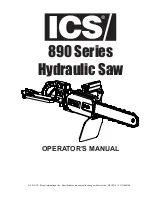
LHFS-210003 Pruner
Greenlee / A Textron Company
4455 Boeing Dr. • Rockford, IL 61109-2988 USA • 815-397-7070
6
Maintenance
(cont’d)
Sharpening the Cutter Blade
When a blade has acquired deep nicks and gouges or
has become too dull to be sharpened with a whetstone,
remove the cutter blade and sharpen it with a fine
metal-cutting file.
1. Disconnect the tool from the power source.
2. Remove the cutter blade from the tool. Refer to
“Cutter Head” in the “Disassembly” section of this
manual.
3. Sharpen the blade with a fine metal-cutting file.
Note: When sharpening with a file, it is impor-
tant to maintain the original shape and contour of
the blade. An equal amount of material must be
removed from all parts of the blade.
Do not
sharpen
the blade to a thin, razor edge. This reduces the
strength and shortens the service life of the blade.
Do not overuse the file. It is not advisable to remove
large amounts of metal from the blade.
4. After the contoured side of the blade has been
sharpened, turn it over so that the flat side is facing
up. Dress the blade with a whetstone just enough to
smooth away any nicks and irregular sharp edges
that may have formed during sharpening of the
contoured side of the blade.
5. Remove any nicks or rough edges on the hook with
a pocket whetstone. The inner curve of the hook
should have a beveled cutting edge. This can be
achieved with the whetstone also. Failure to do this
can ruin a new or sharpened blade.
Tension Adjustment
The tension adjustment should be checked after about
one hour of use on a new cutter. A wearing-in process
takes place during this time and the cutter pivot nut
may need tightening.
The cutter hook and cutter blade must fit together
snugly. If they are too tight, the cutter will not perform
properly. If the fit is too loose, the tool will not cut
cleanly, and damage to the tool may occur.
1. Disconnect the tool from the power source.
2. Refer to figure below. Disconnect the cutter blade
(1) from the linkage that secures it to the extension
rod end.
3. Remove the #10 x 1/4 inch socket head cap screw
(2), #10 lock washer (3) and the lock (4).
4. Tighten or loosen the 3/8-24 cutter pivot nut (5) until
some drag is felt when the blade (1) is opened or
closed.
5. Install the lock (4) over the 3/8-24 cutter pivot nut
(5). Secure the lock (4) with the #10 x /14 inch
socket head cap screw (2) and the #10 lock
washer (3).
Note: If the slot in the lock (4) does not align with
the threaded hole in the cutter hook (6), turn the lock
(4) over. This will allow the lock to be positioned so
that the slot will line up with the threaded hole in the
cutter hook, allowing the #10 x 1/4 inch socket head
cap screw (2) to secure it in place.
6. Reconnect the linkage to the cutter blade (1) and
extension rod end.
1
5
4
2,3
6
Tension Adjustment
Closure Adjustment
Do not change accessories, inspect, adjust, or
clean tool when it is connected to a power source.
Accidental start-up can result in serious injury.
Proper closing adjustment of the cutter is set at the
factory, and should not be re-set until repeated sharp-
ening of the blade or installation of a new blade requires
it. When closed, the blade should cover about 1/3 of the
surface of the cutter hook.
If the blade is improperly adjusted, the blade closure
must be re-adjusted while the blade is in the fully closed
mode.


































